Most people think speed reading is just about moving your eyes faster across the page. But here is the real key: it is visualization. Without strong mental imagery, readers may skim faster but end up forgetting what they read. With visualization, comprehension and memory rise dramatically even as pace increases.
Imagine reading a page of text and instantly transforming words into pictures in your mind. That is the skill top speed readers rely on and it is something anyone can develop. Visualization is not gimmicky. It is a foundational tool for true reading mastery.
Table of Contents
Why Visualization Matters in Speed Reading
Visualization transforms reading from a flat activity into a multi-sensory experience. Instead of simply decoding lines of text, you are essentially watching a “mental movie.” This shift matters because the brain is designed to remember images more efficiently than abstract words.
-
Boosts retention: Images stick longer in memory than abstract words because our brains evolved to recall scenes, faces, and actions more readily than symbols.
-
Increases comprehension: When you form mental pictures, you grasp meaning faster and connect ideas more easily.
-
Reduces rereading: Strong images reduce the urge to backtrack, which slows most readers down.
Visualization makes speed reading sustainable. There is little point in reading twice as fast if you cannot remember what you just read.
The Science Behind It
Cognitive psychology provides solid support. Dual-coding theory explains that the brain processes verbal and visual input in separate yet connected systems. Reading while visualizing engages both systems, doubling retention opportunities.
Neuroscience research shows visualization activates the same brain regions as actual perception. Imagining an action or scene can be nearly as powerful as experiencing it. That is why athletes use visualization to enhance performance. Readers can harness the same effect to boost comprehension.
This also explains why stories are easier to remember than raw data. Narratives naturally create mental pictures, while abstract information requires extra effort to become memorable.
Practical Visualization Techniques for Speed Reading
Visualization is a trainable skill. Here are proven techniques you can start practising today:
1. Chunk and Picture
Break text into meaningful phrases, then form a quick mental picture. For example, “the boy kicked the red ball” becomes a flash image of a boy kicking a red ball.
2. Mind Mapping on the Fly
Sketch in your mind how ideas connect, or jot them down as you read. A mind map turns abstract arguments into visual structures.
3. Movie Reel Technique
Read as if the text is unfolding like a film. Narratives become moving scenes; concepts become visual metaphors.
4. Anchor Images to Key Points
Create exaggerated or humorous images for important ideas. To remember that water boils at 100°C, visualize a teapot erupting like a volcano with steam shooting out.
5. Color Coding in the Mind
Even if the text is black and white, imagine colors. Assign distinct colors to categories or themes—maybe dates in red, names in blue.
For step-by-step mental imagery drills, check out these visualization exercises for speed reading, which walk you through chunking, associating images, and anchoring key concepts.
Common Mistakes to Avoid
Even motivated readers stumble when learning visualization. Watch out for these pitfalls:
-
Over-visualizing: Spending too much time creating elaborate pictures slows you down.
-
Forcing detail: The goal is gist capture, not photographic realism.
-
Skipping practice: Visualization improves with repetition.
-
Neglecting abstract content: Use metaphors or diagrams when text is technical.
Avoiding these missteps helps build speed and accuracy without compromising comprehension.
Building a Daily Visualization Habit
Visualization becomes powerful only when automatic. Like any habit, it grows through consistent practice. Try these strategies:
-
Start small: Begin with a paragraph or short article before tackling full chapters.
-
Use stories first: Narratives are easier to imagine and boost confidence.
-
Add review sessions: After reading, mentally replay the images.
-
Combine with note-taking: Integrate sketches or doodles to anchor visual concepts.
-
Prompt yourself: Ask, “What image does this sentence create?”
Over time, your brain will convert words into images with little effort. That is when speed reading becomes truly effective.
If you want structured practice, this guide on building a visualization habit includes exercises for strengthening mental focus and imagery.
Real-World Examples
-
Fiction Reading: Readers who applied movie-reel techniques reported a 40 percent improvement in comprehension.
-
Academic Texts: Students visualizing abstract models as shapes or diagrams boosted test performance.
-
Professionals: Executives anchored financial data to humorous images, recalling figures in meetings without notes.
Advanced Visualization Techniques
-
Layered Visualization: Add multiple senses for richer recall.
-
Memory Palace: Place concepts in mental “rooms” for later retrieval.
-
Visualization + Speed Drills: Use a pacer while creating images to balance speed with comprehension.
Tailoring Visualization to Different Reading Contexts
-
Fiction: Focus on sensory detail and emotional tone.
-
Non-fiction: Use metaphors or diagrams for abstract concepts.
-
Technical Texts: Turn processes into flowcharts or schematic visuals.
-
Self-help and Productivity: Anchor lessons to quirky images.
Conclusion
Visualization is the hidden engine behind speed reading success. By turning words into images, you don’t just read faster—you read smarter. Your comprehension deepens, retention lasts longer, and the material becomes meaningful.
Next time you open a book or article, pause and ask: What picture does this create in my mind? That simple shift can turn skimming into mastery.
Want to level up your reading skills? Choose one visualization technique and try it during your next reading session. Share your results in the comments, and follow me for more deep-dive articles on reading, learning, and productivity.

